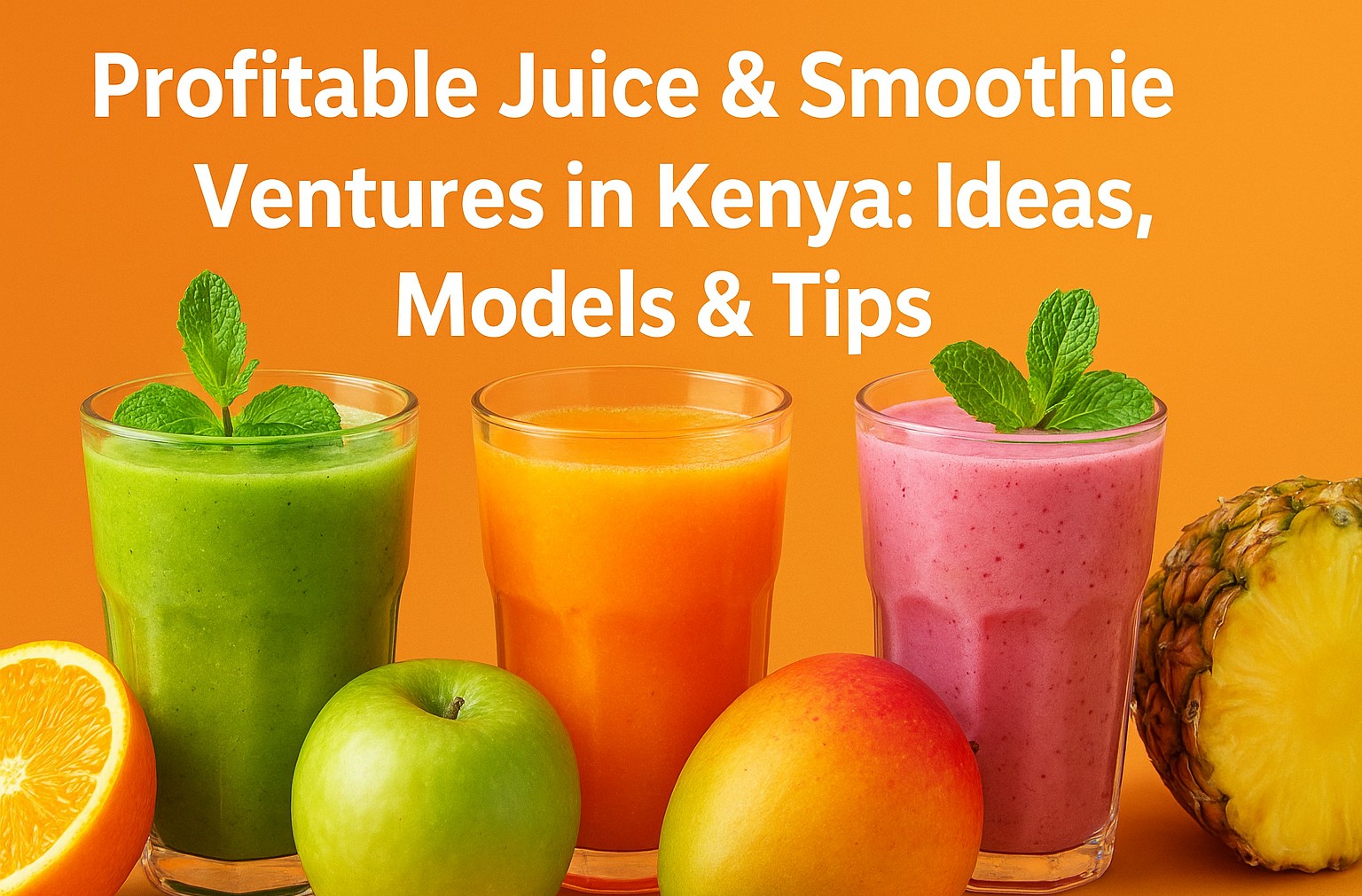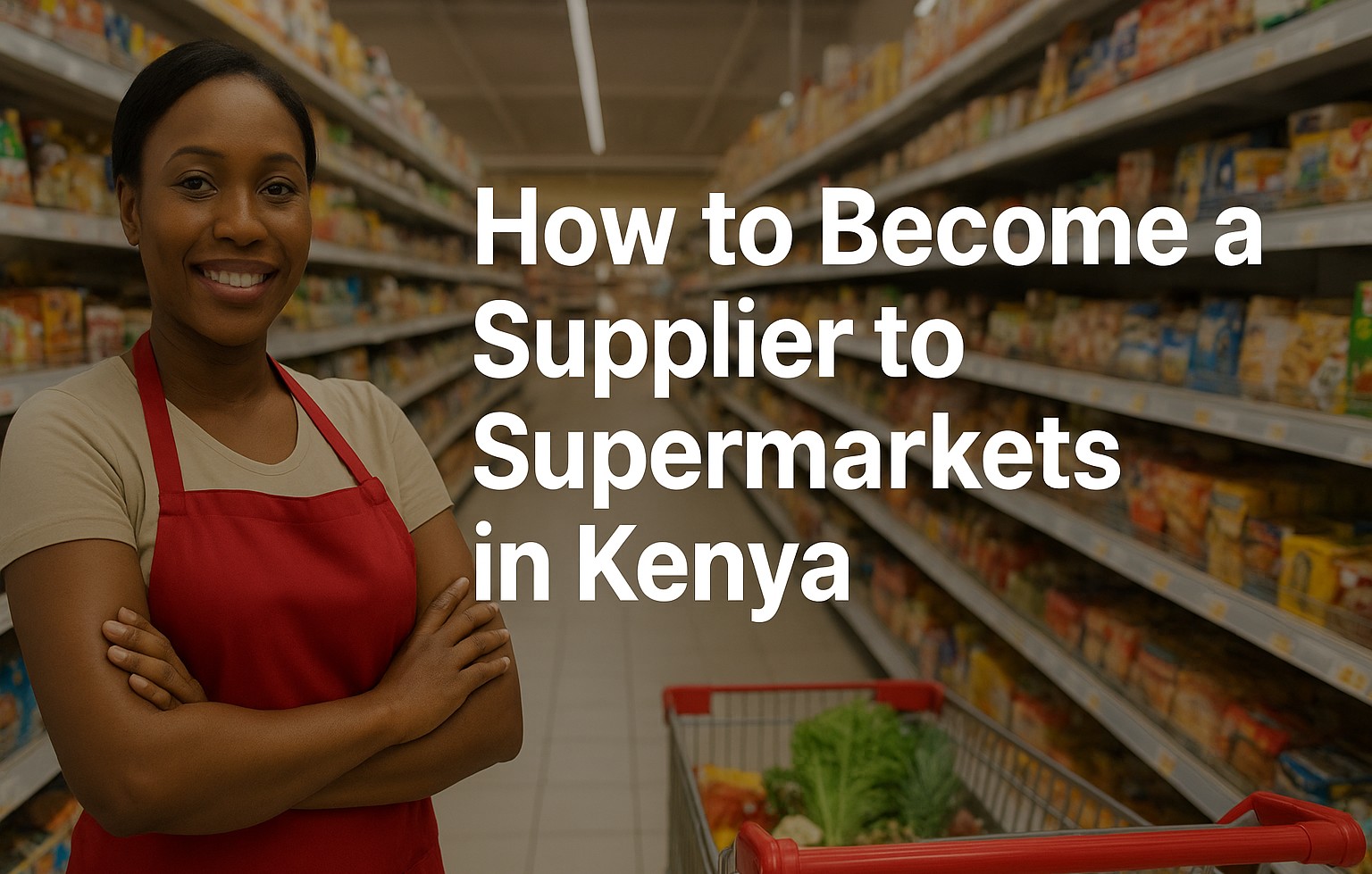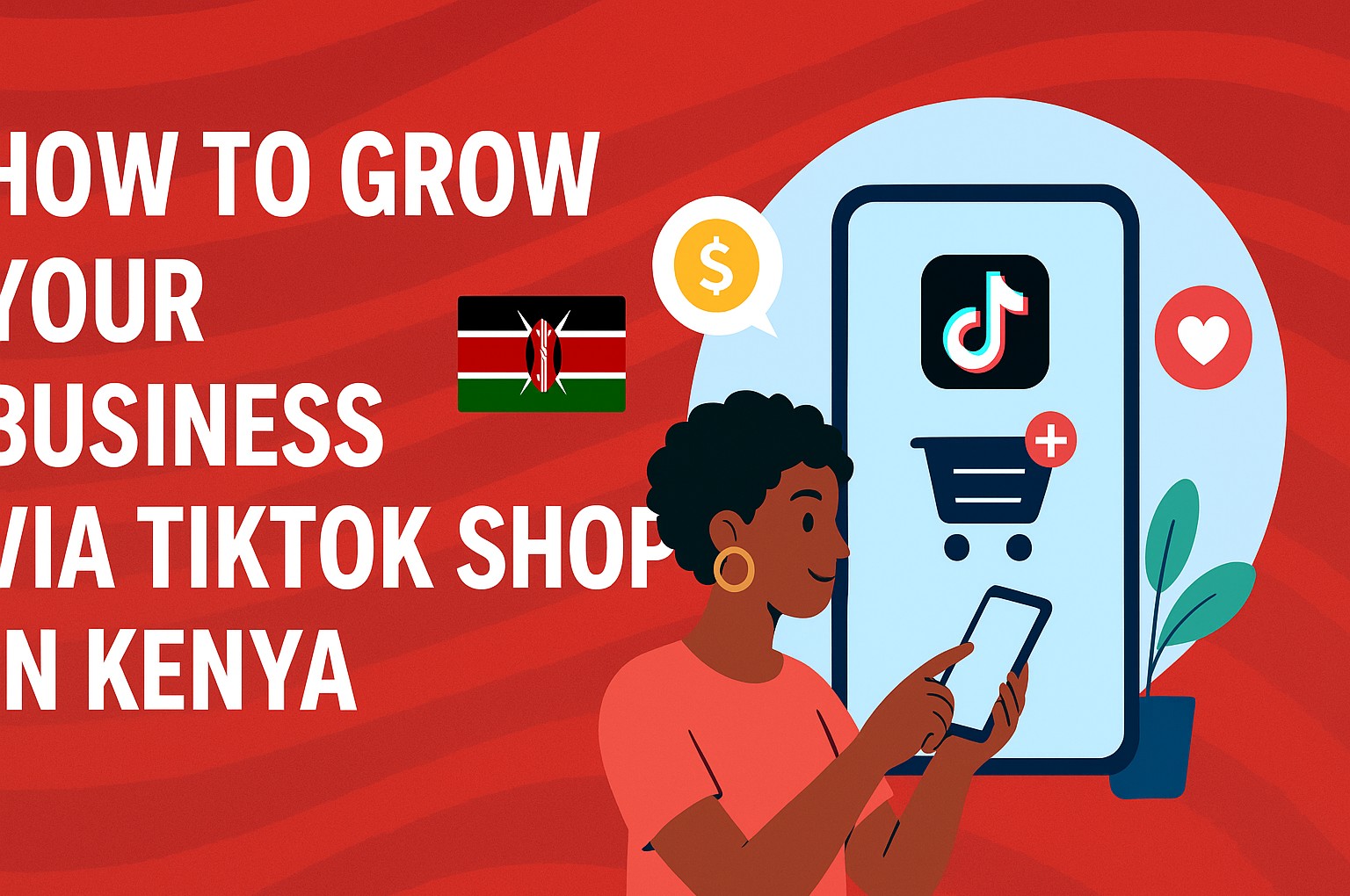

Titus Morebu
Author
Profitable Juice & Smoothie Ventures in Kenya: Ideas, Models & Tips
Explore top juice & smoothie business models in Kenya, revenue forecasts, startup steps, scaling strategies and how to stay ahead in this growing healthy beverage market.
Introduction
Kenya is seeing a rising wave of health-conscious consumers and urban professionals seeking nutritious, refreshing drinks. This creates a golden opportunity for juicy, smoothie, and blended-beverage enterprises. Whether you want a small kiosk, a bottled line, or a full café, this guide covers high-potential and profitable business models in Kenya, plus how to launch and scale them effectively. 🥤
Why Juices & Smoothies Are an Attractive Business in Kenya
- Growing health awareness: More people are embracing wellness, detox, and “clean eating” trends.
- Abundant local produce: Kenya grows a variety of fruits (mangoes, pineapples, avocados, passion fruit) that can be leveraged to lower ingredient costs.
- Fast ROI for small setups: A small juice stand or kiosk often requires modest capital and can break even faster.
- Scalable into packaging: Once a brand is trusted, you can extend into bottled or packaged smoothies for retail distribution.
- Partnering opportunities: Gyms, schools, offices, cafés and delivery platforms provide built-in distribution channels.
Top Profitable Models to Explore
1. Juice / Smoothie Kiosk or Pop-Up Stall
A compact, high-footfall setup (mall, market, near gyms) sells fresh juices and smoothies on the spot. It’s low risk and ideal for testing.
- Low fixed costs (rental, electricity, blender) compared to full-size shops.
- Focus on signature blends and quick turnover.
- Offer combo deals or “add-ons” like chia seeds, protein powders, or wellness shots.
2. Street / Mobile Juice Stand
Use a cart, tricycle, or mobile van to bring your product closer to customers in busy streets, parks, campuses, and events.
- Lower rent burden—mobility lets you chase high traffic areas.
- Flexible with weekends, festivals, sports events.
- Requires consistent fruit sourcing and storage (cooling) logistics.
3. Juice Bar / Smoothie Café
A full shop with seating, ambiance, and a broader menu beyond drinks (e.g. smoothie bowls, salads, snacks).
- Higher overhead (rent, décor, staffing), but higher margins via upsells and café experience.
- Builds brand presence and loyalty.
- Better suited in commercial districts, malls, or affluent neighborhoods.
4. Bottled / Packaged Juices and Smoothies
Produce in a central kitchen and distribute into supermarkets, cafes, or via e-commerce.
- Requires quality control, packaging, cold chain, and shelf-life capability.
- Gives scale, brand reach, and passive sales beyond storefront hours.
- Must comply with Kenya Bureau of Standards (KEBS) and labeling laws.
5. Wholesale / B2B Juice Supply
Supply fresh juices or ingredients to cafés, hotels, events, airline caterers, corporate offices.
- Large-volume orders reduce cost per unit.
- Lower marketing burden—clients find you via reputation and networking.
- Reliability and consistency are critical.
6. Niche & Functional Juices
Focus on detox, immunity-boosting, weight-management, sports nutrition, or “green smoothie” lines.
- Higher price point due to perceived added benefits.
- Targets fitness enthusiasts, wellness communities, and clinics.
- Opportunity for subscription or cleanse programs (e.g. “3-day juice cleanse”).
Revenue & Profitability Benchmarks (Kenyan Context)
Here’s what you might expect in a Kenyan setting:
- A kiosk selling 50–70 cups daily at ~Ksh 100–300 per cup can yield gross daily revenue of Ksh 5,000–15,000 (before costs).
- A smoothie shop with upsells and add-ons (bowls, snacks) can push average transaction value higher.
- Bottled smoothies may command premium prices but also bear packaging, cold storage, and transport costs.
- Some small juice bars report daily net profits (after costs) between Ksh 3,000–10,000, depending on location and scale.
Step-by-Step to Start and Scale Your Juice Business
Market Research & Feasibility
Begin with surveying potential customers, understanding local competition, and estimating demand. A feasibility study helps forecast startup costs, expected revenues, operating costs, and break-even timelines.
Business Plan & Branding
Craft a plan that covers your vision, target customers, revenue channels, marketing, operations, and financial projections. Develop a strong brand identity—logo, packaging, tone—so you stand out in a competitive space.
Location & Layout
- Choose places with high foot traffic (malls, hospitals, gyms, campuses).
- Ensure good visibility, ease of access, and adequate space for equipment and storage.
- Design layout for workflow efficiency (fruit prep, blending, serving).
Licenses, Permits & Compliance
It’s essential to register your business and obtain the necessary food, health, and public health permits. In Kenya, local county governments issue single business permits, and you may need public health and food hygiene certification. Be sure to follow KEBS labeling and quality guidelines for packaged products.
Sourcing & Supply Chain
- Partner with local farmers and fruit suppliers to secure quality and cost efficiency.
- Manage seasonal variations and diversify your fruit mix to reduce risk.
- For packaged lines, build a cold chain (refrigeration, insulated transport, storage).
Equipment & Setup
Key items include commercial blenders, juicers, refrigerators, freezers, display units, packaging machines, and POS systems. Choose durable, serviceable machines to avoid downtime.
Menu Design & Pricing
- Start with a core menu of bestsellers, then rotate unique blends and seasonal specials.
- Consider ingredient cost, perceived value, local palate preferences when pricing.
- Offer customization (extra protein, toppings, size upgrades) to boost margins.
Marketing & Customer Acquisition
- Use social media (Instagram, TikTok, Facebook) to showcase vibrant visuals of your products and engage customers.
- Partner with gyms, yoga studios, wellness influencers, corporate offices for cross-promotion.
- Offer loyalty programs, seasonal promotions, and free tastings.
- List your business on delivery platforms or build your own delivery channel.
Operations & Staff Training
- Train staff in hygiene, customer service, consistent blending techniques, and upselling.
- Establish standard operating procedures (recipes, batch blending, waste control).
- Monitor daily sales, ingredient usage, spoilage and customer feedback to optimize.
Scaling Up & Diversification
- Open additional branches or kiosks in other locations.
- Introduce new product lines (bowls, cold-pressed juice, nut milks, detox cleanses).
- Negotiate distribution deals with supermarkets and retail chains.
- Create subscription models or delivery subscriptions.
- License or franchise your brand to expand coverage without full capital burden.
Challenges & How to Overcome Them
| Challenge | Mitigation Strategy |
|---|---|
| Fruit spoilage & waste | Careful inventory management, rotating menus, small batch processing |
| Seasonality & supply fluctuations | Use fruit blends, preservative techniques, backup suppliers |
| High cold chain and logistics cost (for packaged line) | Optimize route planning, shared delivery, local hubs |
| Competition from bottled drinks & sodas | Emphasize freshness, health, unique blends, branding |
| Regulatory hurdles & compliance | Engage with county health offices early, budget for permits, follow KEBS standards |
Case Studies & Examples of Kenyan Success
Several Kenyan startups and small juice brands have carved out strong local presence by focusing on quality, branding, and partnerships. Some venture into packaged smoothies, while others remain experiential cafés. Others start as kiosks then scale. These success stories show that with discipline and strategy, juice businesses in Kenya can thrive.
Tips to Rank Well & Stay Ahead
- Continuously solicit customer feedback to refine blends and service.
- Use seasonal fruit promotions to keep the menu fresh and exciting.
- Invest in strong social media content—vivid photos, short reels, influencer tie-ins.
- Track metrics: cost per cup, waste, busiest hours, popular blends.
- Stay compliant with hygiene and food safety; a reputation for cleanliness builds trust.
- Collaborate with wellness communities, health coaches, dietitians to expand reach.
Conclusion
The juice and smoothie sector in Kenya holds considerable promise. With low initial capital for smaller formats and the potential for expansion into packaged lines, entrepreneurs can tailor a business model to their risk appetite. Success rests on understanding the market, sourcing smartly, crafting a strong brand, and maintaining operational discipline. Start lean, build trust, and scale smart. May your next cup be profitable! 🍹
Disclaimer: Always consult local health and regulatory authorities before launching any food & beverage business.
Gallery

Related Articles
3 articles
How to Become a Supplier to Supermarkets in Kenya – A Step-by-Step Guide 🌟
Learn how to register, pitch, and win supply contracts with Kenyan supermarkets. Step-by-step process, tips, and legal requirements — your roadmap to success.

Best Money-Saving Strategies for Kenyan Small Business Owners
Practical and actionable tips for small business owners in Kenya to cut costs, boost profits, and build resilience in 2025.

How to Grow Your Business via TikTok Shop in Kenya 🚀
Unlock TikTok Shop Kenya strategies to boost sales, visibility and customer trust with proven tactics for 2025 success.